
by Kate Redmond
Wooly Bear Caterpillar again
Greetings, BugFans,
The BugLady has been doing a little dance as she walks down the trail lately, trying to avoid stepping on wooly bear caterpillars (her mission statement, after all, is “Less stepping on bugs”). She has been less successful when she drives. So, it’s time to rerun this episode that originally aired in 2009, but that she re-posts every five years or so. A few new words; some new pictures:
Wooly bear caterpillars are tiger moths in the family Erebidae and in the subfamily Arctiinae. It’s a diverse family that includes almost a thousand species of tiger, underwing, Zale, tussock moths, and more, in North America, and many more worldwide (except Antarctica). If you have an older insect guide, tiger moths are in the family Arctiidae, but everything that was once in Arctiidae has been folded into Arctiinae. Tiger moths are unusual in that they have an organ on their thorax that vibrates to produce ultrasonic sound. They “vocalize” to attract mates and to defend against predators. If you have sound-making ability, you also need “ears,” and those are on the thorax, too. Like tigers, the adults of many species are hairy and sport bold color patches, stripes or patterns.
Many tiger moth caterpillars are fuzzy, earning a group name of wooly bears or wooly worms (two “lls” or one “l” – take your pick. Two lls is more common in Britain and one l is more common here). The wooly bear du jour is the ultra-familiar rust-and-black-banded caterpillar whose grown-up name is Isabella Tiger Moth (Pyrrharctia isabella) https://bugguide.net/node/view/1937881/bgimage. The caterpillar goes by the generic Wooly Bear, and also Black-ended Bear, and the Banded Wooly Bear. Pyrrharctia is a “monotypic genus” – there’s only this single species in it, and they’re only found in North America. There is an amazing amount of information out there about wooly bear caterpillars, and much of it is contradictory, a problem that is exacerbated by the fact that there are many different kinds of caterpillars that are called wooly bears.
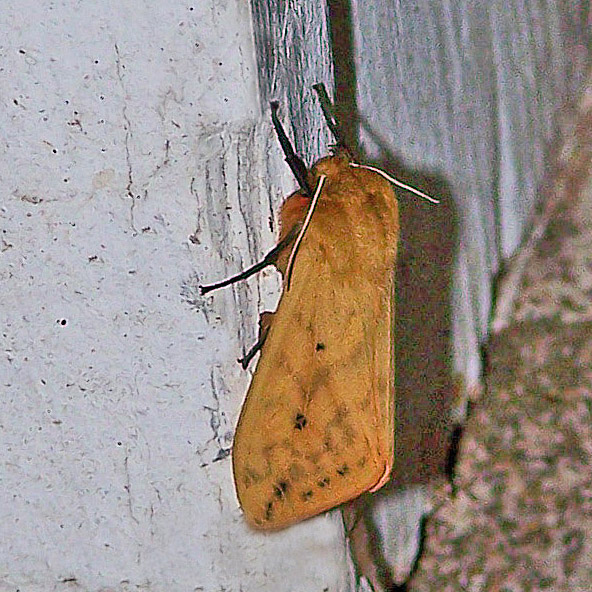
A mature female Isabella Tiger Moth “calls” to males by emitting pheromones (chemical signals) at night, and the males zero in on her by using their sensory antennae. Isabella Tiger Moths lay their eggs on a wide variety of plants during the warm months. While some caterpillars are known for their picky eating, wooly bears are generalists. They feed during the day, munching on handy, low-growing plants like grasses, “weeds” and wildflowers (cannibalism has also been reported). Their catholic eating habits ensure that they’re constantly surrounded by food during their autumnal wandering in search of wintering sites.
Wooly bears spend the winter as caterpillars, out of the weather under tree bark or debris, or in your garage. Do they become “bug-cicles”? Yes, indeed – they’ve even been found frozen in a chunk of ice. But, like other organisms that are dormant in the dead of winter, wooly bears produce a chemical called a cryoprotectant (antifreeze) that protects living tissue against damage from freezing and thawing. Wooly bears will stir and walk around on mild winter days and then go back into hiding when the temperatures drop again. They wake up with the warm weather, resume eating, and pupate in late spring in a fuzzy cocoon into which they incorporate their own “setae” (hairs) https://bugguide.net/node/view/2249302/bgimage. According to Wikipedia, Arctic summers are so short that wooly bears may need to live through several of them to become mature enough to pupate.
One area of disagreement among references is whether the wooly bears’ wool/setae/hairs/bristles are irritants. Having a bristly covering discourages some predators, although in the Fieldbook of Natural History, E. L. Palmer says that “skunks and a few other animals roll hairs off the caterpillars before they eat them.” Certainly, the stiff hairs make it a harder to pick a wooly bear up, and when you do pick one up and it inevitably curls into a defensive ball, it’s pretty slippery. Some sources say that the wooly bears’ setae contain a stinging/irritating/venomous chemical, and other sources specifically say they do not. Still other references say the setae may cause dermatitis mechanically – that they might break off in your skin (like one of those wretched, furry cacti); and others say that that unlike many hairy caterpillars, wooly bears are harmless. The BugLady has never suffered any ill effects from handling the familiar, rust-and-black wooly bears.
Wooly bears have been famous since Colonial times for two things: 1) their habit of crossing the roads in fall (the BugLady wonders what they crossed before the Colonists arrived and started making roads); and 2) their alleged ability to predict the weather.
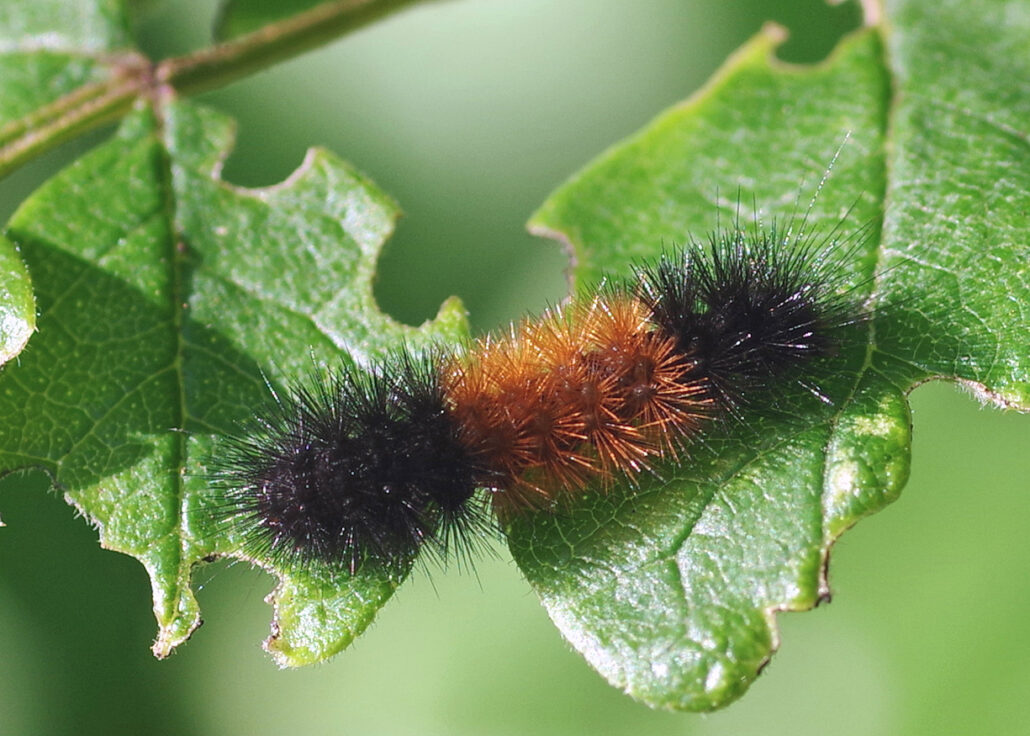
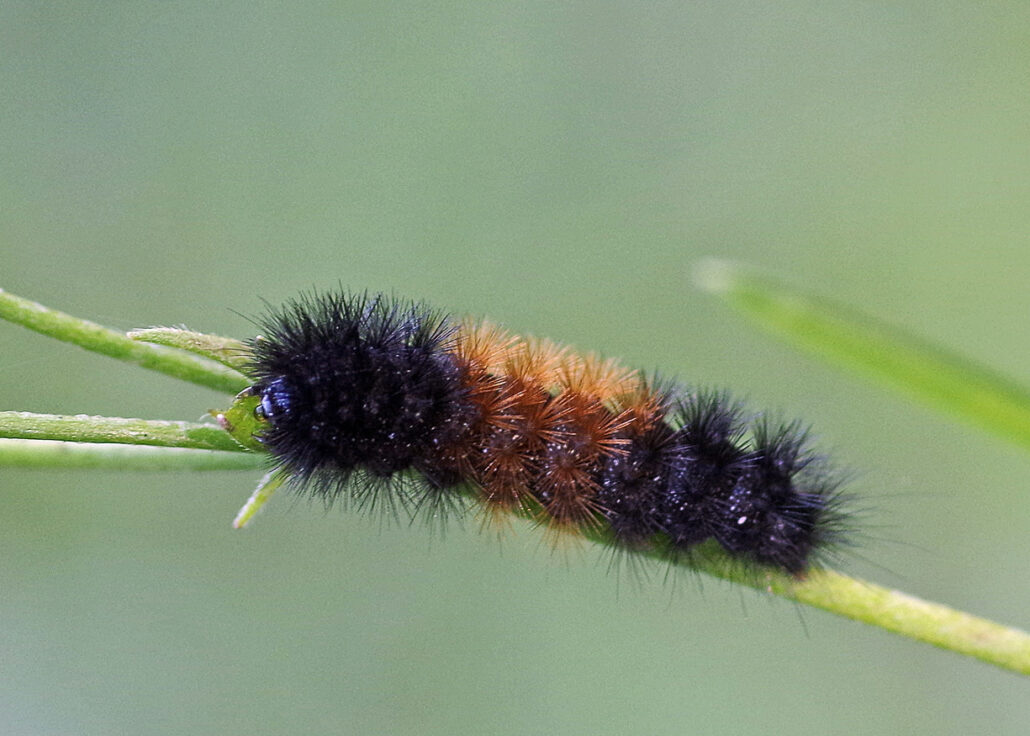
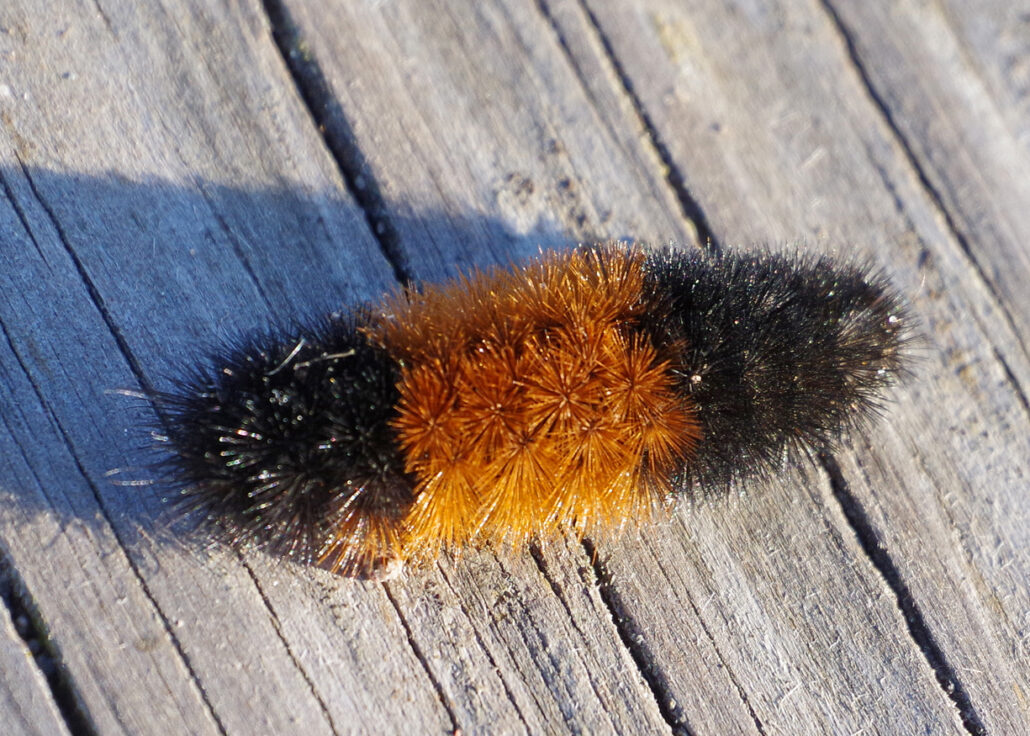
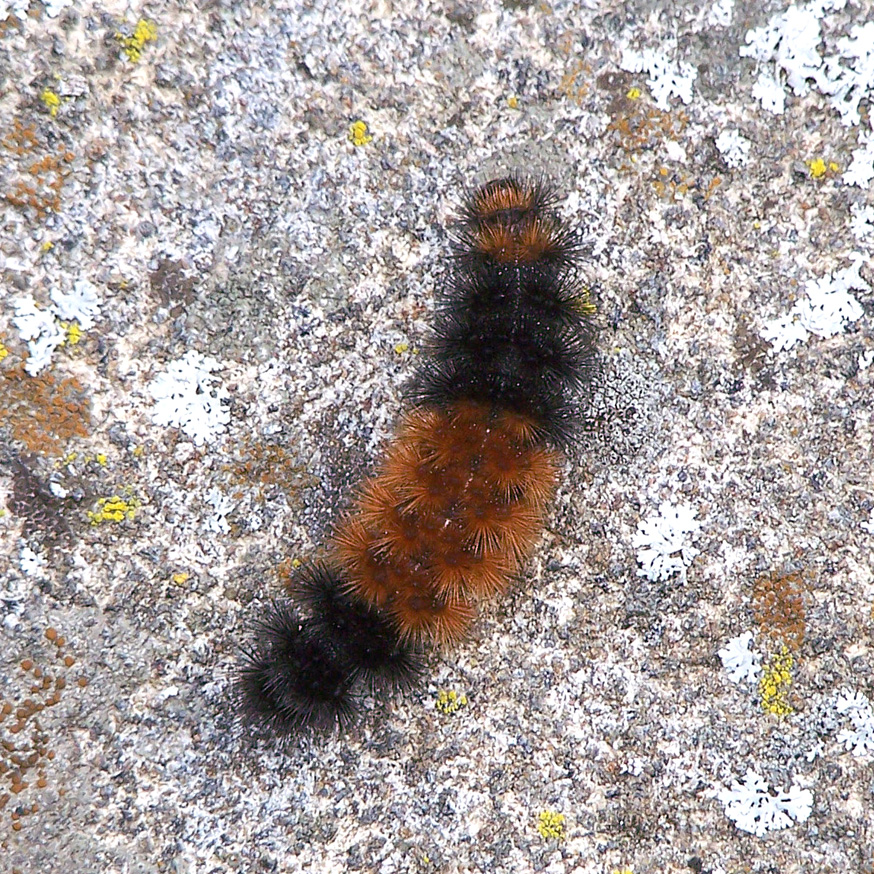

The weather lore angle was initiated by those same, road-building Colonists, who needed some forecasting done in those pre-Weather Channel days so they could figure out when to plant and harvest crops. If its rust-colored middle band is wide, says the Almanac, the winter will be a mild one; if there’s lots of black, batten down the hatches (except for a few sources that say the opposite – that lots of rust means lots of cold).
A surprising number of scientists have felt obligated to leap in and deflate the weather story. To them the BugLady says “Lighten up, Party Poopers, and let a little fantasy into your lives.” They tell us that the widening middle band is a result of age, and that each time wooly bears molt, a black band becomes a rust band (except for a few who say the opposite – that rust turns to black). So, a rustier wooly bear is an older wooly bear. The BugLady has been curious about why the early fall wooly bears seemed more pessimistic than the later fall wooly bears and is happy to have that one resolved. In spring, a blacker wooly bear is one that became dormant prematurely, and may indeed be telling the weather – of the previous fall. Other research suggests that a wooly bear with lots of rust lived in dry conditions, and one source says that a wooly bear with wide black bands grew up where the habitat was wetter. Still other scientists say that there is considerable variation in color within newly-hatched individuals from a single clutch of eggs, and that the variation persists as they age.
We have Dr. Curran, a curator of insects at the American Museum of Natural History, to thank for popularizing the wooly bear. Charmed by the old weather saying, Dr. Curran drove north from New York City along the Hudson to Bear Mountain State Park each year for eight years in the late 1940’s and early 1950’s to measure the coloration of the wooly bears he found there. During those years, the rusty bands predicted mild winters. He leaked the forecasts via a friend at a NYC newspaper, and the publicity his reports generated put wooly bears on the map. But Dr. Curran’s only real hypothesis was that Scientists Just Want to Have Fun. He and his friends enjoyed the scenery, the foliage and the wooly bears on their annual fall forays and formed “The Original Society of the Friends of the Woolly Bear.” Thirty years after Dr. Curran’s outings ceased, the folks at Bear Mountain State Park resurrected the Friends organization and the wooly bear count.
Wooly bears are embraced by children and adults alike, and Annual Wooly Bear Festivals are celebrated:
- in Beattyville, KY, launched in 1987, where wooly bears race up dangling strings http://www.beattyville.org/tourism/feastivals-and-events/;
- in Vermillion, OH, begun in 1973, featuring a costume contest for children and pets https://www.vermilionohio.com/woollybear-festival/.
- in Banner Elk, NC, started in 1977, highlighting a race with more than 1,400 racing caterpillars; the winner gets to make the forecast. Because of Hurricane Helene, the 2024 fest will be held virtually https://woollyworm.com/webfest/;
- in Lewisburg, PA, where the celebration includes a pet parade https://www.northcentralpa.com/community/lewisburg-to-host-fall-festival-and-woolly-worm-prognostication/article_287b7c68-8583-11ef-a2e3-fbde1381eb41.html.
- in Little Valley, New York https://www.facebook.com/events/352940344570478/352940354570477/?active_tab=about .
Clearly, Wisconsin is missing the boat, here (though Milwaukee had a third annual Wooly Bear Fest in January of 2015).
Go outside – chart wooly bears.
Kate Redmond, The BugLady
Bug of the Week archives:
http://uwm.edu/field-station/category/bug-of-the-week/
